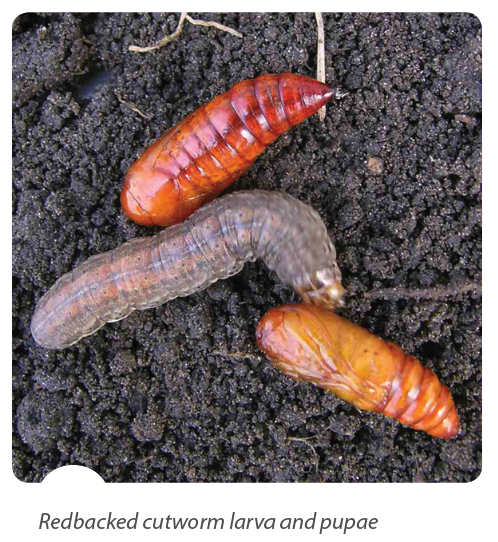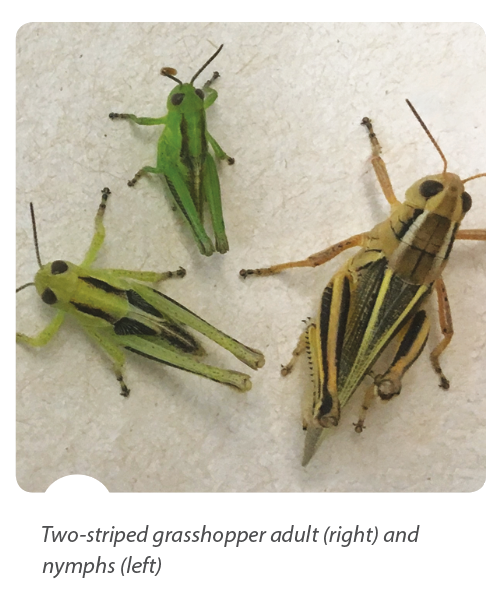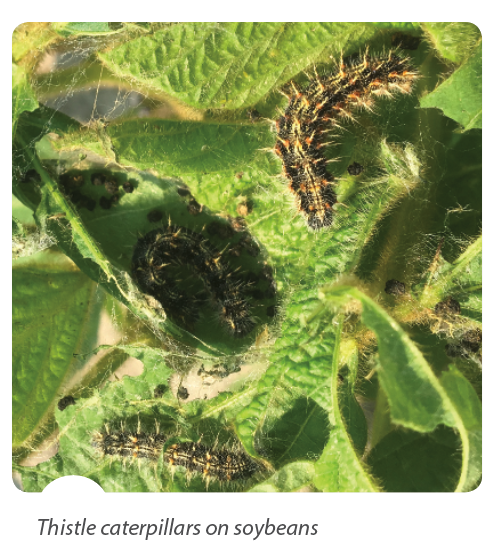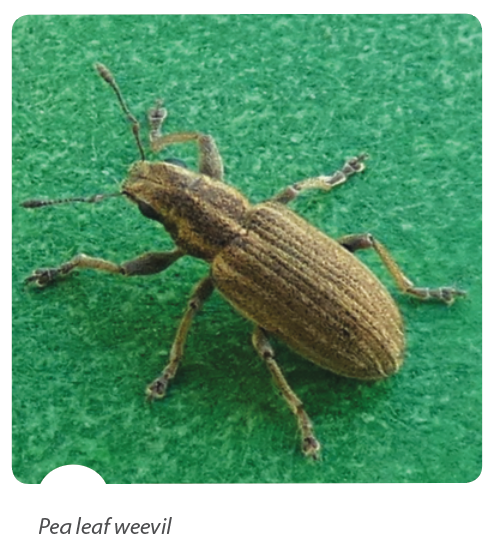John Gavloski, Entomologist, Manitoba Agriculture and Resource Development
While doing general field scouting of pulse and soybean crops, it is not unusual to find a lot of insects in the fields. That is not always a bad thing, as many times, most of what is there are beneficial insects (decomposers, predators, parasites) or insects not capable of causing significant yield or quality problems. But there are a few insects that can cause significant harm to pulse and soybean crops, and some of these were at levels that were capable of causing damage in 2019. This article will focus on those insects that were of economic concern this past growing season, plus a potential pest of peas that was found for the first time in Manitoba in 2019.
CUTWORMS
Cutworms were of economic concern in dry beans, faba beans, peas and soybeans in 2019. There were extensive insecticide applications, as well as some reseeding of soybeans, peas and faba beans.
Cutworms overwinter in Manitoba, so farmers and agronomists will want to make scouting for them a priority as the crop starts coming up in 2020. They can be a tough insect to monitor because they are nocturnal, spending the day hiding under debris or in the soil, and coming out at night to feed.
Several species of cutworms can be present in pulse crops and their lifecycles can differ. That can result in cutworms being present for quite an extended period in the spring if the population is a mix of species. The dingy cutworm overwinters as partially grown larvae, while the redbacked cutworm overwinters as eggs. These are two of our common species of cutworms in Manitoba.
Different species may result in there being some variability in sizes of larvae and extend the length of time cutworms are actively feeding.
Cutworm populations can be quite patchy and levels can vary greatly between nearby fields. Because of this, field scouting is important. Levels may be low and uneconomical in some fields and higher in others. Even within a field, the population can be high in a patch or specific area of the field and lower in the rest of the field. If this is noted, then controlling cutworms in the infested patches may be the most economical option.
Some crops, such as peas, have the ability to compensate for some of the feeding by cutworms, while other crops have little ability to compensate. Peas cut early and at the soil surface regrow or branch from subsurface nodes.
GRASSHOPPERS
Reports of high grasshopper populations and control were more common in soybeans than pulse crops. Grasshoppers were of concern and insecticides were applied to control them on soybeans in many areas. In some instances, just headlands were treated. Harvest of nearby crops at times resulted in grasshoppers moving into soybeans. Some noticed grasshoppers moving into fields after field margins or ditches were mowed.
Although pulse crops do not seem to be preferred by grasshoppers, they will feed on them, particularly when other crops have started to mature, and later-harvested pulses and soybeans are among the few green options available. Often with pulse crops and soybeans, the infestation is much heavier around the field edge and treating the field edge is all that is needed, although, in years of high grasshopper populations, there can be exceptions to this.
Scouting for grasshoppers should begin early in the season. Our pest species of grasshoppers overwinter as eggs and hatching usually starts in late May or early June. In many instances, most grasshopper eggs will have been laid at the edges of fields, or along the roadsides. Since young grasshoppers can’t fly, early-season populations are often concentrated around field edges. If high populations are detected early, early season control along the field edges may prevent more serious problems later in the season. Also, lower rates of insecticides can be used on young grasshoppers than adult grasshoppers.
If grasshoppers do start feeding on pulse crops, realize that low levels of defoliation will not cause economical yield losses.
Research in Ontario indicated that prior to flowering, beans are able to tolerate up to 50% leaf loss with minimal losses in the final yield. Complete defoliation prior to flowering delayed maturity by 30 days. Lower levels of defoliation did not delay maturity. The impact of defoliation is more significant at later stages. Losses will depend on the growing conditions and the ability of the plant to recover. Losing more than one-third of the leaves during flowering or pod fill can greatly reduce yield.
Action thresholds for grasshoppers in dry beans are 35% defoliation before bloom and 15% defoliation after bloom. Often a border spray is all that is needed. Thresholds for grasshoppers are similar for soybeans. A rescue treatment may be warranted if the defoliation exceeds 30% during pre-bloom (i.e. vegetative) stages; 15% from bloom to pod-fill; or 25% from pod fill to maturity (unless pod feeding is observed).
THISTLE CATERPILLARS
Thistle caterpillars are the larvae of a butterfly called the painted lady butterfly, which overwinters in southern California and Mexico. They migrate towards the prairies, often arriving in June, although in some years they can be entirely absent. They normally prefer to lay eggs on Canada thistle plants, but under some conditions will lay eggs on other plants, such as soybeans or sunflowers, as well. Large amounts of painted lady butterflies began to be noticed in early June in some areas this year. Thistle caterpillars started to be seen in soybean fields in late June. Some soybean fields in the northwest and eastern regions were sprayed to control thistle caterpillars in earlier/mid-July. Thistle caterpillars were also noticed on Canada thistle and round leaf mallow.
Larvae feed on leaves of their host plants and also build a nest by producing a loose webbing, which at times may result in the leaves being folded or tied together. Frass produced by the larvae may become entrapped in the nest.
A suggested threshold for thistle caterpillars in soybeans is 25 to 30% defoliation of plants on average before bloom; 20% after bloom or pod set. In some literature, you will see a nominal threshold in the pre-bloom stages of soybeans as 40% defoliation.
Regardless of which is used, soybeans can handle a fair amount of defoliation before yield is significantly impacted. It would be rare for soybean fields to, on average, have this level of defoliation from thistle caterpillar, although plants or patches within a field can certainly go beyond this. When assessing a plant for the level of defoliation, make sure to consider all the leaf material on the plant. Sometimes individual leaves are heavily defoliated, while other leaves have very little.
Unlike many crop species, soybeans have a remarkable capacity to withstand a lot of defoliation without significant yield loss. They do this by both tolerating and compensating for leaf loss. Yield losses are prevented because soybean plants typically produce excess leaves. Also, when leaf loss becomes too high, plants can help compensate for losses by retaining older leaves and maintaining high levels of photosynthesis. Soybeans can also compensate for stand losses. Usually, gaps in soybean stands are filled by
additional growth and branching of the remaining plants. In this way, soybean yields are maintained despite substantial defoliation or reductions in plant population. These tolerance and compensatory traits of soybean reduce the need for insecticides or other management tactics in many situations.
In soybeans, a 40% leaf loss during any vegetative stage will result in a three to seven percent yield reduction. Defoliation of 20% during the pod-forming and pod-filling stages will result in similar yield reductions. This information can help you gauge the economics of defoliation and whether insecticides would be economical.
PEA LEAF WEEVIL
Larvae of pea leaf weevils feed on the nitrogen-fixing nodules on pea roots. High levels of such feeding inhibit the nitrogen-fixing ability of the plant, which can reduce yields if the soils are nitrogen deficient. The first record of pea leaf weevil in Alberta was in 1997, and it was first found in Saskatchewan in 2007. At the start of this year, it had not been confirmed from Manitoba but had been detected in eastern Saskatchewan.
An agronomist from northwest Manitoba sent in four weevils collected in early September from pea stubble near Swan River. The agronomist commented that they are easy to find in harvested pea fields. The weevils were identified as pea leaf weevils. That is the first confirmation of pea leaf weevils in Manitoba.
Only field peas and faba beans are potentially at risk of damage from pea leaf weevil. Other crops in the bean family may be fed on by adults but do not suffer significant damage from larvae.
In 2020, we will be trying to determine the range of pea leaf weevil within Manitoba. That will require us finding the adult weevils.
They can be captured in pheromone-baited traps, or collected from plants they may be feeding on. Adult weevils chew the leaf margins, resulting in a characteristic notching along the leaf margins. Pea growers or those scouting pea crops who think they may have pea leaf weevil in their field are advised to contact John Gavloski, entomologist with Manitoba Agriculture, or a production specialist with Manitoba Pulse & Soybean Growers. That will assist us in tracking the distribution of pea leaf weevil in Manitoba.




